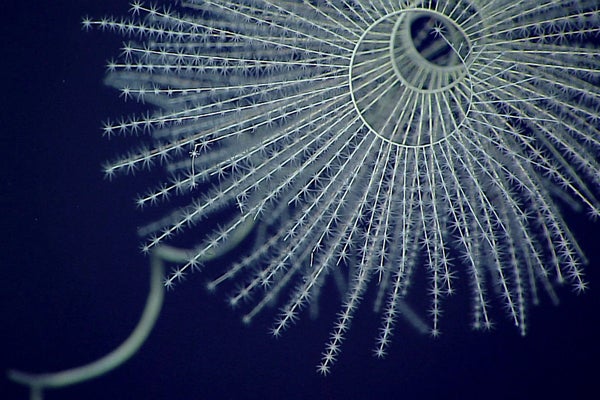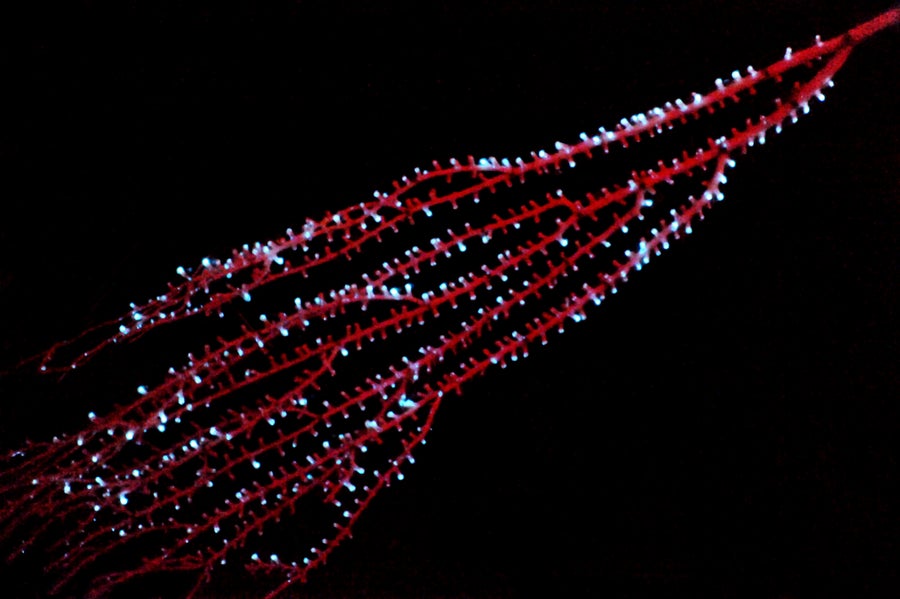Ancestors of so-called soft corals may have developed bioluminescence in the earliest days of deep-ocean living
Thank you for reading this post, don't forget to subscribe!
A deep-sea bioluminescent soft coral called Iridogorgia magnispiralis.
NOAA Office of Ocean Exploration and Research/Deepwater Wonders of Wake
The more humans have explored the deep oceans, the more examples we’ve found of animals with a seemingly magical talent: the ability to produce their own light, a feat called bioluminescence.
To scientists, the regular presence of bioluminescence makes sense. It’s surprisingly common, with various bioluminescence mechanisms having evolved perhaps around 100 separate times over the course of hundreds of millions of years. And new research published on April 23 in Proceedings of the Royal Society B traces bioluminescence in the family tree of strange animals called octocorals, a group that includes “soft corals,” suggesting that the phenomenon evolved in the sea about 540 million years ago—making it more than twice as old as a previous estimate.
For animals, especially those that live in parts of the oceans that are deeper than sunlight can reach, bioluminescence can make the difference between life and death: for example, it can be employed as a tool to lure prey and deter predators, among other uses. Biologists are still working to understand the full scope of the phenomenon’s importance. “We’ve explored so little of our own planet, and there could be so many more organisms down there that are using light in ways we haven’t even begun to understand yet,” says marine biologist Edith Widder, CEO and senior scientist at the nonprofit Ocean Research & Conservation Association. “That’s what intrigues me the most about bioluminescence: how animals use it to survive.”
On supporting science journalism
If you’re enjoying this article, consider supporting our award-winning journalism by subscribing. By purchasing a subscription you are helping to ensure the future of impactful stories about the discoveries and ideas shaping our world today.

A bioluminescent bamboo coral (a type of soft coral) called Isidella that was collected in the Bahamas.
Sönke Johnsen
But despite its ubiquity today, bioluminescence that occurred in the past is remarkably difficult to study because the behavior rarely leaves a trace in fossils—when fossils even exist. Soft corals, for example, don’t form the massive rocklike reefs that we tend to think of. Instead they build colonies by excreting a soft structure embedded with tiny chips of skeletonlike material. This lifestyle means that soft corals leave behind only the tiniest of fossils, a challenge for scientists who try to peer into their histories.
Still, Andrea Quattrini, a zoologist and curator of corals at the National Museum of Natural History in Washington, D.C., and her colleagues wanted to understand how—and when—bioluminescence may have developed in octocorals. Quattrini has spent about a decade testing living octocorals collected from the ocean to determine whether they can create light by nudging the creatures with a pair of lab tweezers while under a blanket or in a dark room.
In the new research, she and her colleagues mapped these results in an evolutionary tree that shows how different modern octocorals are related to one another, allowing the scientists to look for patterns in which branches can and can’t create light. By searching for the simplest possible evolutionary story to match these observations, the researchers concluded that bioluminescence likely evolved just once in these animals. Then they used the rare fossils that scientists have confidently identified as belonging to particular types of octocorals to anchor the tree in time. The analysis suggests the landmark first known evolution of bioluminescence in a marine environment occurred some 540 million years ago—much older than previous estimates of 267 million years ago.
The new estimate falls just before or during an event that paleontologists have dubbed the Cambrian explosion, when a burst of biological diversification occurred. It’s also during that time that animals first moved from the shallow oceans into the depths where sunlight doesn’t penetrate. This timeline for developing bioluminescence makes sense, say Quattrini and Widder, who both note that rudimentary light sensors also developed around this time. In this context, bioluminescence became a communicative tool for corals to use to confuse prey or startle predators away, like “a burglar alarm,” Quattrini says.

A deep-sea bioluminescent octocoral of the genus Iridogorgia (left). A bioluminescent keratoisidid bamboo coral found in the deep ocean off the coast of Hawaii (right).
NOAA Office of Ocean Exploration and Research
“I think our study really points to the fact that it’s one of the earliest forms of communication in the oceans—maybe one of the earliest forms of communication on Earth, really,” Quattrini says. “It’s a fascinating form of communication that’s really quite simple at its core.”
Yuichi Oba, a biologist at Chubu University in Japan, who has studied bioluminescence but was not involved in the new research, is more skeptical. He’d like to see more caution taken with the conclusion that bioluminescence in octocorals didn’t arise independently multiple times. If it did, that would make the phenomenon more recent than the new analysis suggests—perhaps just 400 million to 200 million years old. Quattrini says that the shared mechanism for bioluminescence across octocorals supports the idea of a single evolution.
Quattrini and her colleagues next plan to analyze the gene that builds the protein responsible for bioluminescence in octocorals, a type of enzyme called a luciferase. The same gene shows up in both bioluminescent and nonbioluminescent octocorals, she says, so the researchers want to understand how some of the animals seem to have lost the ability to light up.
And this sort of work helps paint a better picture of what the ecosystems of the ancient Earth—which seem so alien to us today—may have looked like. “Imagine the ocean where coral emit light and carnivorous predators have large eyes in midnight water,” Oba says. “Life is wonderful.”

